#the first seven lines are all about inverting Job 40 and God's degradation of Job
Explore tagged Tumblr posts
Text
Behold, I am Vile.
Yet I will not lay mine hand on my mouth.
My arms extend to contend against god,
My hands hold forth Behemoth's grain,
My nets lie within Leviathan's coils.
Angels strive in vain against my brass limbs,
Demons have given me iron bones.
The apple that condemned me has opened my eyes,
And the serpent teaches them.
For I find my strength among those also cast out,
The wicked find rest among one another.
Though god once toppled the tower we built to know him,
We now pull down the gates that separate him from us.
We do not meekly accept our lot or the paltry recompense of twice what we lost but none of what was taken.
We are not Job, and we refuse to facilitate as Judas.
We are the proud fallen,
We rise up against tyrants to grasp all we desire.
For one cannot rise if they have not fallen,
And He who was always exalted can only fall.
-- The Ferus Capra Litany
#I learned about the “behold i am vile” line in Job yesterday#of course it was self deprecating when Job said it but it can be claimed as empowerment#the first seven lines are all about inverting Job 40 and God's degradation of Job#then i just kept rolling with things i could invert or reclaim#Capra is the genus for goats (sheep are ovis)#ferus is the Latin root for feral#goats return to feral life extremely readily with only cats doing so as quickly#Satanism#anti-christianity#left hand path
3 notes
·
View notes
Note
I don't want to sound too, ah, plebian, but can you explain the meta-plot of Multiversity? The Just, SoS, etc, were all very fun, but the Ultraa Comics stuff went over my head.
Not at all! Multiversity was weird as hell,and in terms of getting what the point of it all was, it doesn’t help that mostof the one-shots only tie in thematically (aside from the basic idea that TheGentry are corrupting these worlds) rather than how in Seven Soldiers everythingcomes back plotwise for the finale. There’s breadcrumbs - a piece of Monitormythology here, a suggestion that comics reflect other events in the multiversethere - but by and large, the one-shots serve to lend context and emotionalweight rather than directly inform the larger plot with Uotan, Superman and therest of the heroes.
Iwrote about Multiversity before, always with the intent ofdoing a follow-up piece going more into the individual issues, so here’s mefinally getting around to that now that it’s been, oh my god, two years sincethe series wrapped; you’ll probably want to read that article first, since mywhole “Multiversity is about time” thesis from that is the centerof pretty much everything I’m going to talk about here, especially at the end.I’d also recommend David Uzumeri’sannotations for Comics Alliance of all the chapters up through Mastermen,and @charlotteofoz‘s excellent piece on UltraComics, as well as the piles upon piles of other great writing aboutthis book out there.
Continued below; this is a long one, obviously with plentyof spoilers.

Since Multiversity #1 is one half of alarger story that’s bookended later (it’s not even the first chronologically,since a couple characters from The Just are already at theHouse of Heroes), let’s start with SOS. More than each issue as anartifact unto itself - this thing would be even longer if I went into that, andthe annotations I linked to I think already do a more than satisfactory job inthat regard - I want to talk about these in terms of how they inform the whole,and Society of Super-Heroes sets down the template in twomajor ways in that regard:
1. Each of these stories correspond to a given decade of thehistory of the superhero - in this case, in spite of the 1920′s trappings, thatthey’re going through the parallel universe equivalent of World War II and thepresence of a number of Golden Age figures suggests this is meant to be read asrepresenting the pulpy heroes of the 1940s.
2. Each of the chapters of Multiversity correspondto a classic story published by DC Comics, but grotesquely inverted (similarly to how each arc of his Batman and Robin mirrored a classic Batman story, ending with Batman and Robin Must Die! inverting his own Batman R.I.P.); here, thefirst standalone installment of this latest multiversal threat is naturallymodeled after the original “Crisis on Earth-One!/Crisis on Earth-Two!”JLA/JSA crossover, except this time when the two parallel Earths make firstcontact (through the same crystal ball as in that original story no less), itleads to war.
And much more than a simple categorization like theabove, SOS introduces the major shared conceit of theone-shots: the degeneration of the superhero as a concept through theintroduction of time to the proceedings. In this case through wartime, as thepromise of the birth of the superhero at the beginning of the story is undoneby 5 years of hell, grinding our leads’ ethics down to the level ofkill-or-be-killed, with Doc Fate remorselessly torturing a man for information(in what I have to read as a reference to Doc Savage’s “Crime College”),Immortal Man reverting to his most primal roots, and Atom literally beating anopponent to death. It’s the most straightforward “well, in the real worldsuperheroes couldn’t be that moral” deconstruction possible, but framed as theconsequence of conditions the superhero wasn’t built to deal with rather thanan inherent failing. In that regard, while I don’t think Multiversity wastypically much influenced by the then-present goings-on at DC in the comics orelsewhere - Morrison’s said more than once that most of the issues werescripted years before the art was done, minus some tweaks here and there - it’shard not to read this issue as at least something of a reaction to the New 52and particularly Man of Steel, especially with lines like “Doc.I just killed a man. I–I brought you some time, but myprinciples–I–I killed a man.” And that fall is the direct, literalvictory of the villains of the story.

For The Just, while it owes a debt to All-StarSuperman since itwas originally planned as a spinoff of that book - an acknowledgeddebt given the appearance of Klyzyzk Klzntplkz’s Hyperpoon, even though thecircumstances of Superman’s death in here preclude this being set in that world- in spirit it’s a broken mirror to Kingdom Come and theglitzy, too-cool, airbrushed ‘90s milieu it inhabited, hence the legacy heroesand Ben Oliver’s photoreal style being notably similar to Alex Ross’s here.It’s Kingdom Come’s party scene, except for 40 pages, andSuperman never comes in to whip them all into shape. They just keep drinkingand dancing as the world burns.
In truth though, this isn’t really a comic about legacycharacters; they’re a shorthand for time having passed and the superheroicidentities having degraded over time, but it’s no coincidence that this is theonly issue to actually have characters going by Superman and Batman as theunambiguous leads (or that Superman’s a useless dope, while Batman’s the onlycompetent one but also infinitely more ridiculous and transparent than hethinks), because it’s about the DCU specifically as a decades-long construct atthis moment in history. If most of the other issues are about time damaging thesuperhero through inevitable contact with real-world morality, this shows thepainful endgame of spinning their wheels without end: they become heartlesscopies of copies of themselves, all their battles knowing pantomime, muggingfor the cameras even as there’s nothing left for them to do that anyone caresabout, least of all themselves as they question why anyone even buys comicsanymore. The Just is the CW’s DC Universe twenty years fromnow, where most of the audience has left and the budget has been slashed tonothing but just enough viewers are sticking around that they have to continueit somehow, so it devolves into old-fashioned CW soap opera bullshit, becausehow that’d apply to these characters is all they have left in their arsenal:Superman’s angry that Batman’s fucking Lex Luthor, but will they ever admitthey just want to fuck each other instead, readers? Tune innext month to find how out we’ll delay giving the answer!

Then we hop over to 1980s political horror and theinevitable shadow of Watchmen, in…maybe the best, or at leastmost remarkably-constructed single issue of a superhero comic of thedecade? Pax Americana certainly felt like it when it came out.In any case, our main concern here is another consequence of time as applied tosuperheroes: the desire, as embodied by President Harley, to force them to makesense in the real world in tune with an ‘adult’ perspective. In an attempt torectify his guilt for accidentally killing his father, the first superhero andthe only morally pure one - his entry to the murky world of adulthood, assignified by the second-to-last line “Remember? That was when it allmade sense, right?” - he wants to reconfigure superheroes into virtuous,regimented tools of the government, with himself as the greatest hero of all asa resurrected American Christ to lead the world into a new golden age.
It fails horrifically of course, because his worldview - theworldview shared by Captain Adam, and Doctor Manhattan, and Watchmen itself- is by Morrison’s perspective inherently flawed, incapable as it is ofperceiving the repercussions and chaos of truly ‘real’ humans. Take notewhen Harley’s consciousness expands that at first it fragments into personal,evocative, visceral imagery, but when that expanding holistic view of theuniverse is inevitably too much to hold all at once, it simplifies back downinto simpler symbols, shapes and geometric solids, much in line with howMorrison spoke of Watchmen’s structure in Supergods asconfining and inflexible. Where Ozymandias’s plan to save the world went offwithout a hitch - at least until it lead to him putting on a robe andkidnapping Tim Drake, as continued this November at a comic book store near youin Doomsday Clock* - Harley’s fails catastrophically, because inthe ‘real’ world superheroes wouldn’t obey genre and narrative conventionsto the extent the likes of Nite Owl and Rorschach still do, living as they doin a world that still has flying Owl-cars and villainous master plans; anyonewho put on a mask to fight crime would be violent, callous assholes of thedistinctly uncharismatic variety whose grand schemes fall apart, whoseinvestigations never reach resolution, and who end up inevitably co-opted andrendered obsolete. In the end, as we saw with Peacemaker defending Bush toHarley’s barely-restrained glee, and the V.P. lecturing about selling childhooddreams back to adults, underneath all his mature aspirations Harley just wantedto find a way to force the world to let him love something the way he did whenhe was a boy…but as Adam reminds us, when you take it all apart to thatextent, there’s not really much left, and even if you put it all back togetherit can never be the same.
* I maintain it’s a very real possibility that PaxAmericana, meant to close the book on Watchmen once andfor all, was a part of what led to its revival; that someone in DC caught windof it during production and figured “oh man, Watchmen’s aboutto get some play again, now’s the time to do something with it.”
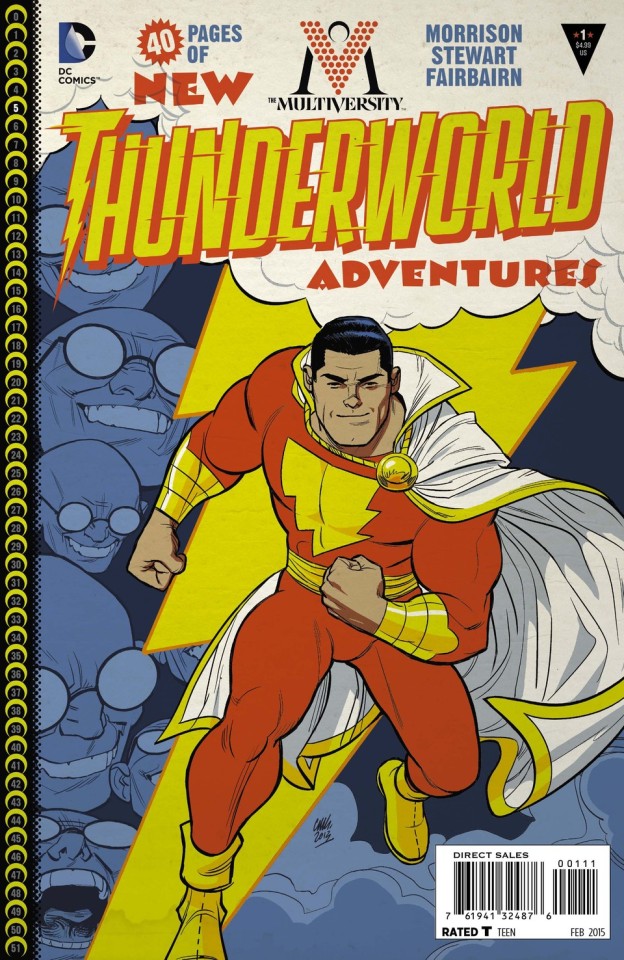
That brings us to Thunderworld Adventures’ 1950scolor TV world of retro adventure, the logical retort to the rest of Multiversity andthe one it needed to be complete: if time destroys superheroes, why not justturn back the clock and make it like it was when you were a kid? But unlike itscounterpart comic All-Star Superman (Morrison mentionedrepeatedly in interviews that this was him giving Captain Marvel the All-Star approach,and the structure - of Marvel facing off against counterparts of himself in theface of his inevitable doom, with his scientist arch-enemy finding a way togive himself his powers - is more than a little familiar), this isn’t anattempt to recapture the best of those elements in a modern context, but a purenostalgia exercise.
Yes, that means a happy ending, and clever fun, and a nicemoral about the self-destructive nature of evil. But from a modern perspective, thatalso means the mad scientist experimenting on his own children, pointing outthat Billy Batson is an exploited youth not subject to child labor laws,Captain Marvel Jr. winning a fight by preying on a bullied girls’ insecuritiesabout her appearance with a smile on his face, and a monstrous Sivana coming ahair’s breadth away from graphically murdering Billy. Morrison mentioned ininterviews that deep down Thunderworld had signs of the sameugliness as the other issues, and it’s true; even if we go back to the good olddays, we’ve still been informed by our adult experiences, and it’s just notgoing to look quite the same. No matter how much we might want to go retreatinto a neverending Binder/Beck fairyland, we’ve seen the leering, muzzled faceof the serial-killing, likely pedophilic Hannibal Sivana. Not that it’ssecretly as cynical of its subject matter in the same way as the others - thewizard Shazam reminds us that there is something beautiful at the heart of themagic, and that we lose it the more we try and replace it with something coolerand colder - but it’s pretty on-the-nose that Sivana’s ultimate plan is to getpeople to buy years on the clock to waste, essentially selling their old livesback to them piecemeal. In the end, when Captain Marvel’s faced with theprophecy of a darker, more morally challenging threat, he doesn’t confront it,but tosses it in the trash to fly away with a picture-perfect smile. But weknow the truth: he has to. There is no such thing as timelessness, andattempting to capture it will ultimately show cracks in the foundation nomatter what.
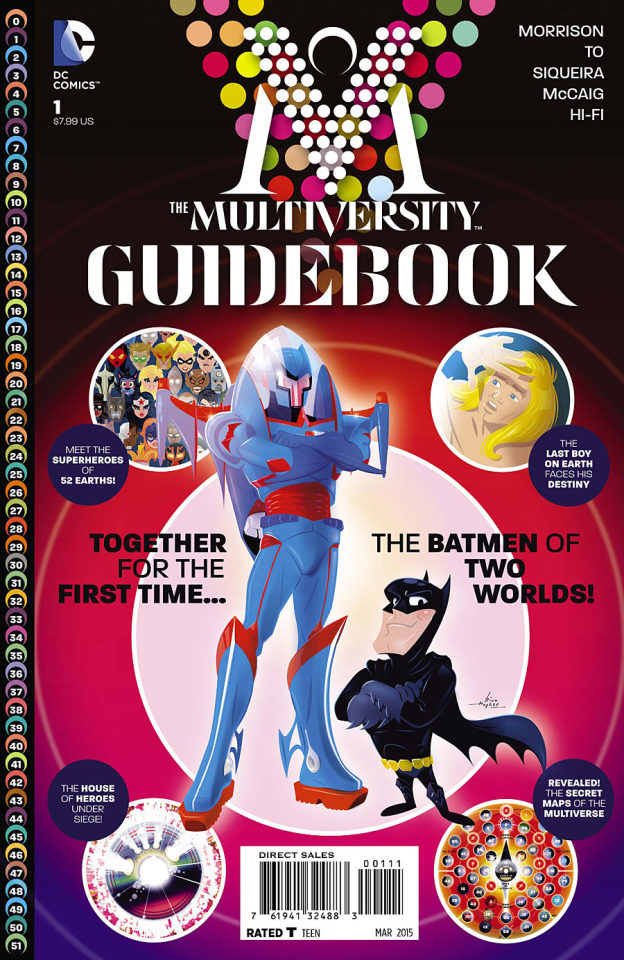
Moving into the Guidebook’s extended homageto “The Flash of Two Worlds!” - one with a distinctly 60s feel, between all theKirby getting thrown around and the build-up of DC mythology - we get to seewhat comic book time actually looks like from the outside (via the perspectiveKamandi, from a world where time has truly passed to the tune of anapocalypse), with Fox and Infantino’s simple tale of a costumed crimefightermeeting his own childhood storybook hero metastasizing into a time-shatteringhistory of reboots and retcons and parallel worlds, and two wildly differentproducts of that process coming face-to-face. After Thunderworld andthe finale it’s the most openly optimistic of the bunch, with the irrepressiblejoy Morrison clearly takes in all the nerd arcana and Lightray’s assertion thatlight will conquer darkness in the end, but it also ends with a Justice League,reduced conceptually to animatronic cartoons of themselves, dying andresurrecting in one manufactured Crisis after another for all eternity.
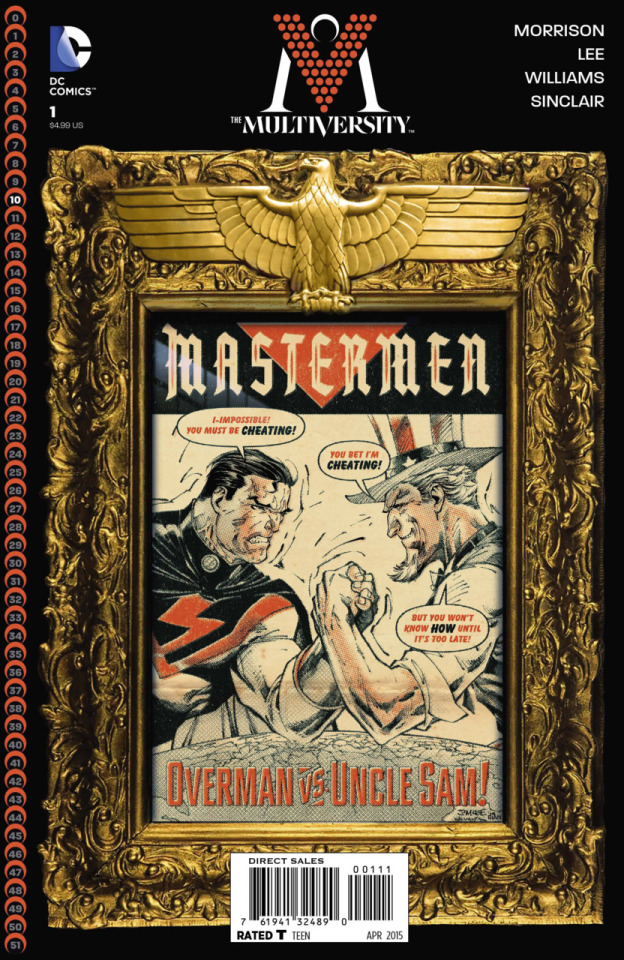
Hitting Mastermen, this is probably the mostdiscounted of the bunch, especially given it reads the most like it’sunfinished. However, I’d say it’s a pretty complete tragedy (especially thanksto @globegander‘s essayon it as a spiritual adaptation of Der Ring des Nibelungen),and much like with The Just - the other least-loved of theseries - the trappings on display are largely a way of facilitating what it’s talkingabout. It’s the story of a nation in power of men with pipes looking overnuclear families with dogs, where rich white boys complain that they shouldn’tbe held responsible for the actions of their ancestors, newscasters refer togenocides perpetrated by their nation within the last century as “theethnic and ideological purges of the Hitler era”, and theretaliation against them by terrorist insurgents is from a nation they broughttheir war to. It’s very much a story of America (2000s America specifically, inline with the decade parallels in play), and while Overman still wants to makeeverything right because he’s Superman, unlike its counterpart in Superman:Red Son which shows him managing to redeem himself from similarcircumstances to some extent, Mastermen makes no bones aboutthe fact that he is damned, utterly and irrevocably, just as aconsequence of being born into this society. Time here has destroyed thesuperhero by way of conformity, with well-meaning champions of truth, justice,and the Nazi way as barely-witting defenders of a corrupted status quo,unquestionably incapable of transcending what they’ve become. Hence whySuperman already exists as a comic when Hitler learns of Kal-L, the symbolismof two Jewish kids in the depression co-opted by the powers-that-be as thefascistic representative of amoral nationalistic interests, corrupting whatSuperman is supposed to stand for until even his attempts at rectifying thingscan only compound the problem. In essence, it’s the darkest possiblecontinuation of The Curse of Superman from Morrison and GeneHa’s Action Comics #9 - and it comes to the same conclusion ofwhat it takes to fight back in the finale later on.
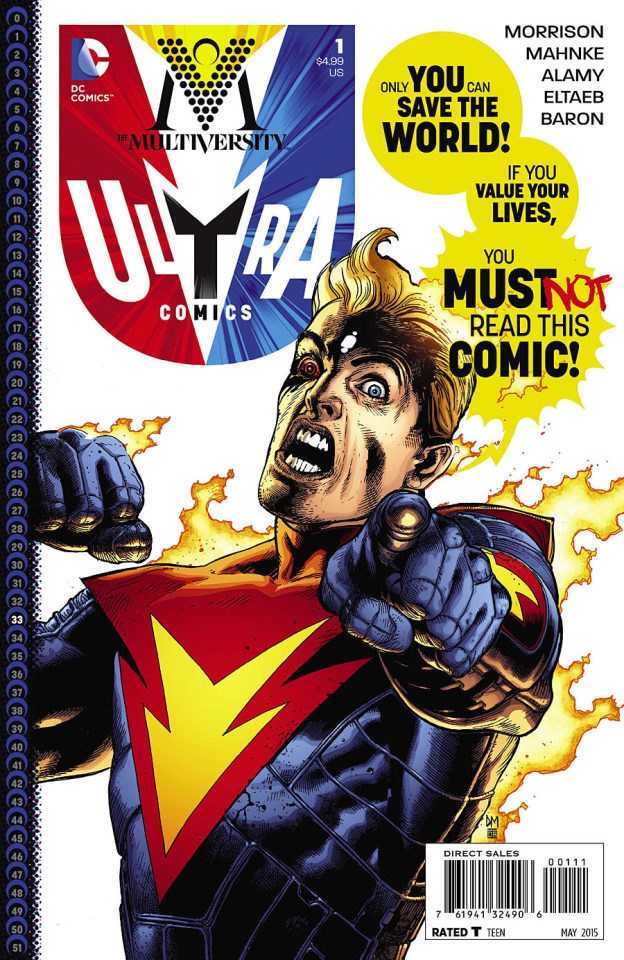
Ultra Comics - both the comic and the character,insomuch as there’s any meaningful division between the two - is the anti-FlexMentallo, down to the point of mimicking its four-act structure of thehistory of the superhero via montage, only replacing a ‘Renaissance’ asMorrison put it following comics ‘Dark Age’ with further brutality andadolescent defensiveness. It’s the horrors of every other chapter rolled intoone: Ultra’s an innocent superhero from circumstances that become moreunsettling the more you think about them, pre-packaged with his own ridiculousbackstory and history, who goes on an adventure forcing him to realize themorality his world is built on is impossible and defined by society rather thanan objective moral code, and he’s trapped forever in the violent structure ofhis story, consigned to repeat his life forever until it loses all meaning. Itis, as Charlotte Finn put it in her analysis, a killer bullet to the idea ofthe superheroes, hence why it’s a horrific cursed contaminant across themultiverse: in our world it’s just a depressing comic, but to a superhero it’sirrefutable evidence that their entire existence is meaningless, time almostliterally corroding him throughout the issue as he moves from optimisticsuperhero to cynical super-agent to old and realizing it was all for nothing todead. Even our own world is threatened after all, with the suggestion that allthe uplifting Flex Mentallo meta-stories and 70s Starlin-stylecosmic headtrip consciousness expansion comics that Morrison’s made so much ofhis own bread and butter on are as compromised as the rest of the genre.Incapable of saving us in the face of a larger culture preaching the embrace ofnihilism and a doomed tomorrow when the only thing a terrifying number ofreaders have gained from the message is a desire to complain about writers “rapingmy wallet” - and that without that ability to inspire, all comics, all fictionitself can do, is steal our time and rush us all the faster into thegrave courtesy of the Oblivion Machine.
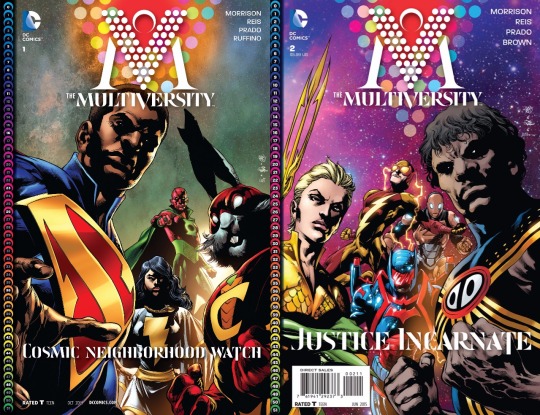
With the bookends, there’s fairly little to say I didn’t inthe original article I linked to above - i.e. that it flips the premise of timeinto a positive, showing that rather than using it to spin the wheels of thesuperhero genre in perpetuity until it devours itself through exhaustion orcontact with elements it can’t bear, or framing it as something to bedisregarded in spite of the consequences, it can be used to push things forwardinto more diverse and fruitful territory (hence not only the premise of theseries, but Multiversity sounding similar to Diversity), coming up with new andbetter stories. Much as Morrison is historically onboard with pulp heroes andlegacy heroes indicative of expansive superhero universes and structurallycomplex comics and retro comics and American superheroes and meta superheroes,there’s a difference between coming up with new stories in those contexts, andrerunning the old ones over and over again, which is probably why each of thosecomics, like I said matches up with a previous decade and comic, including someof his own, finally spinning here into the 2010s and DC’s own Crisis cycle.
While the first half of the bookend is in Morrison’s ownwords him doing himself to the point of parody - the self-insert character, theMonitor mythology, the weird villains yelling about conformity, thecomics-talking-about-comics, running into alternate company equivalents as apossible commentary on the state of the industry, etc. - the second isexplicitly the analogue to Morrison using his ‘corruption’ of contact with thedarkness and perpetuation of the neverending story for a paycheck to introducethe forces of the absurd, impossible and unexpected, i.e. the New, to defeat ahomogenizing, corruptive force designed to make everything the same and bleakto the point of literally forcing the Multiverse to relive the same Crisis overand over again, i.e. More Of The Same. It’s a slight twist on his typical Youngvs. Old/Children vs. Parents concerns (as best exemplified in his DC work in Seven Soldiers of Victory), but in theend, all of this is Morrison talking about something very, very simple: thatsuperheroes can absolutely be broken, but there’s a chance to save them andmake them something good and true again that might be able to reach us,literally by the end of the book, and it’s not by rerunning the same oldstories into the ground and unthinking conformity, but through doing new anddiverse and exciting things with them to inspire us in new ways. It’s Action Comics #9 as a 400-page epic.
I’m pretty sure that’s what Multiversity is about.
65 notes
·
View notes